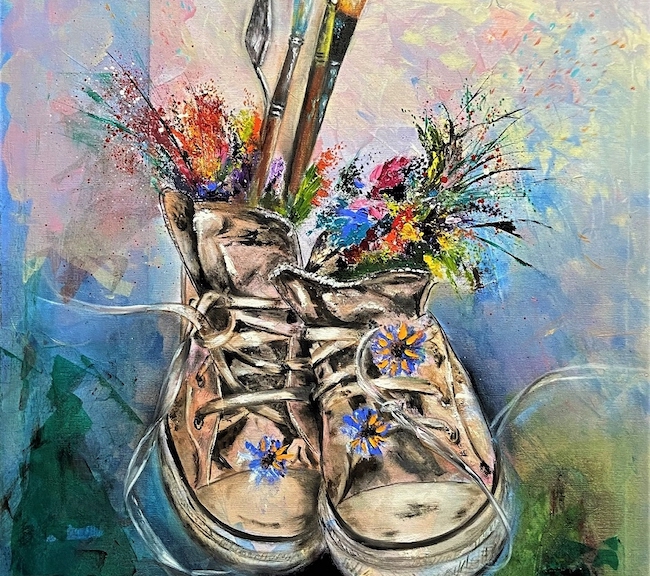Tutto ciò che appartiene all’irrazionalità tende a essere messo in secondo piano rispetto alla contingenza, all’osservazione di quanto si muove intorno alla contemporaneità con le sue problematiche, le sue finte libertà che in realtà sono gabbie all’interno delle quali l’essere umano, e più ancora l’artista, si muove per esplorare i significati più profondi intrappolandosi di fatto in un meccanismo di causa ed effetto che non gli consente di uscire da quel vortice mentale ed emotivo. L’artista di cui vi racconterò oggi invece utilizza l’atto pittorico per lasciar emergere il lato magico dell’universo che abitiamo, fatto di energie sottili, di personaggi e di oggetti apparentemente ordinari che rivelano le infinite possibilità di un mondo parallelo in cui ogni cosa può modificare la sua essenza e trasformarsi.
A partire dagli ultimissimi anni dell’Ottocento, con la ricerca sul colore e sull’emozione degli artisti che contribuirono a teorizzare le linee guida del Fauvismo, riprese ed elaborate nella loro accezione meno estrema dal conseguente Espressionismo, si cominciò a delineare in qualche protagonista dell’epoca, l’esigenza di evadere dalla contingenza, da un periodo in cui le lotte di classe e i successivi venti di guerra inducevano alcuni creativi con una particolare sensibilità a cercare una via di fuga, un modo per distogliersi dagli accadimenti e dal susseguirsi degli eventi a causa dei quali le emozioni assorbite potevano essere solo panico, paura, ansia, angoscia. Questa necessità di sfuggire al reale ebbe il suo massimo rappresentante in Marc Chagall, le cui atmosfere giocose e leggere incastonate in ambienti fiabeschi conquistarono il pubblico e gli esperti proprio per la loro capacità di distrarre da una realtà spesso troppo faticosa, triste, e di trascinare l’osservatore in quel mondo sorridente e forse volutamente incosciente nel quale essere semplicemente felici. Qualche anno dopo quel senso di innocenza e di piacevolezza che fuoriusciva dalla magia dell’esistenza, da quelle piccole emozioni date dall’amore, dalla sensazione di elevarsi e volare sopra le città e sopra i paesaggi con lo stesso desiderio irrazionale di un fanciullo, si mitigarono e si agganciarono a un maggiore senso del reale all’interno di cui però gli artisti andavano a ricercare proprio quella magia che in Chagall era più manifesta; quel nuovo approccio venne definito Realismo Magico e, pur non essendo mai stato un movimento definito e determinato da un manifesto, ebbe i suoi maggiori rappresentanti in Felice Casorati in Italia, Christian Shad in Germania e in George Tooker negli Stati Uniti. E fu soprattutto negli Stati Uniti che il Realismo Magico assunse molte delle tematiche surrealiste dando però predominanza alla magia e all’atmosfera della fiaba e del sogno, generando così il Pop Surrealismo che interessò non solo l’arte bensì anche il cinema. Il grande regista Tim Burton rientra in questa corrente espressiva così come la grande pittrice Margaret Keane, che fu in qualche modo anticipatrice del nuovo stile pittorico, e poi in epoca più recente Mark Ryden, le cui atmosfere irreali spaziano dal mondo delle favole a quello degli incubi nascondendo costantemente una vena ironica sulla realtà. L’artista milanese Katia Papaleo costituisce un ponte tra il Realismo Magico e il Pop Surrealismo per il suo descrivere un mondo molto vicino alle atmosfere cinematografiche di Tim Burton in cui ruotano personaggi od oggetti fantastici e misteriosi ma sempre positivi, quasi come se il regista, così come la Papaleo, rivelassero la loro indulgenza, la loro benevolenza nei confronti delle stranezze che tutto sommato entrano ed escono in modo apparentemente casuale dalla vita di ciascuno.
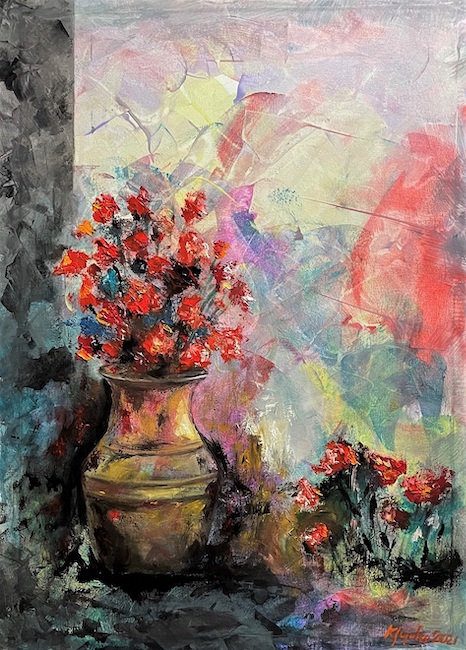
Anche la gamma cromatica scelta dall’artista si armonizza al suo modo di osservare le circostanze, gli eventi, quei dettagli dell’esistenza che dimostrano un significato differente, spesso nascosto eppure evidente a chi sa guardare oltre; le cose assumono un aspetto vivo, divengono metafore della realtà contemporanea oppure, se osservate da un altro punto di vista, si trasformano in modalità per intuire quel legame tra oggetti ed energie sottili che avvolgono le atmosfere che abitualmente circondano l’individuo senza che egli stesso ne sia consapevole.
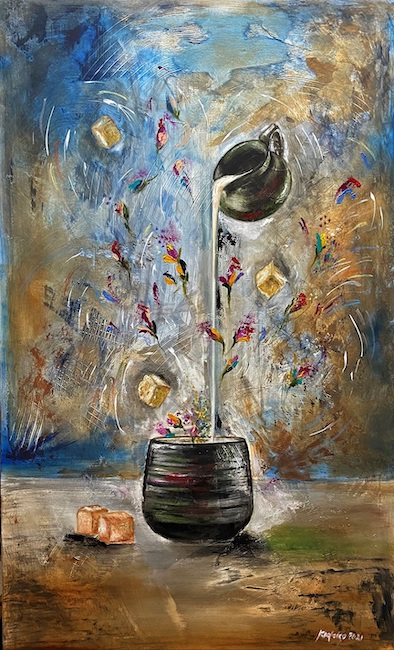
L’opera Fermare il Tempo non può non portare alla memoria le anfore arabeggianti in cui vengono contenuti olii preziosi, raccontati dalla Papaleo attraverso minuscole particelle variopinte e piccolissimi frammenti dorati, quasi fossero lingotti aurei, a sottolineare quanto sia importante considerare il trascorrere degli eventi e della vita come un’esperienza meravigliosa e unica; per questo è necessario prendere atto di quanto sia essenziale assaporare ogni istante perché esso inevitabilmente sfuggirà, malgrado gli sforzi dell’uomo per fermarlo, per non far dissolvere un frangente piacevole e gioioso che però passa.
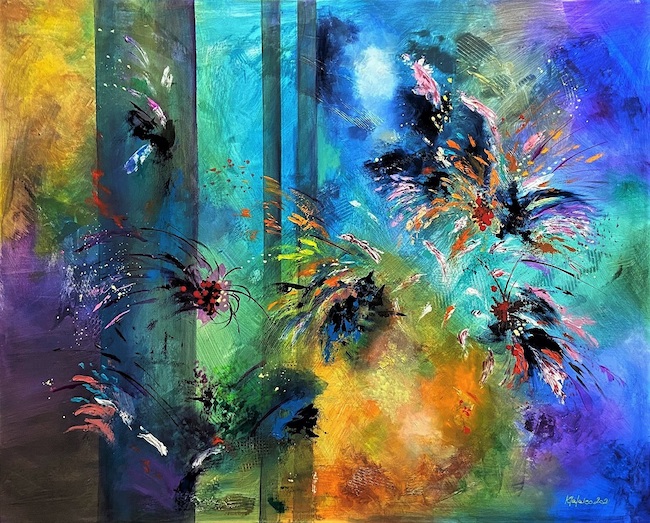
La riflessione sul tempo è un tema affrontato da differenti angolazioni da Katia Papaleo, un concetto che appartiene alla contemporaneità quanto al passato poiché da sempre costituente un enigma, una chimera inarrivabile esattamente per quella fuggevolezza che non appartiene al punto di vista dell’essere umano, spesso convinto illusoriamente di poterlo controllare, di poterne disporre a proprio piacimento, salvo poi dover fare i conti con tutto ciò che è trascorso molto più velocemente di quanto abbia potuto osservare.
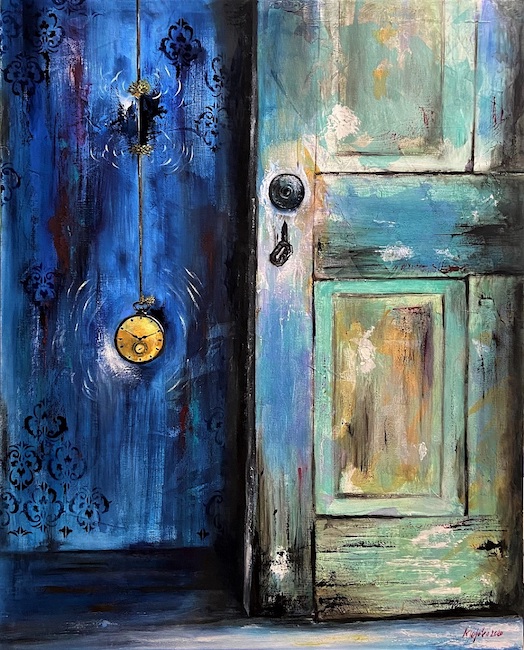
Nella tela Il tempo prezioso l’artista evoca un’atmosfera magica, fatta di toni di azzurro, il colore del sogno, dell’immaginazione, in cui un orologio domina su una porta aperta che rappresenta le opportunità, le occasioni da afferrare, i tentativi da intraprendere per non doversi trovare più tardi a rimpiangere ciò che non è stato colto. L’orologio non appare minaccioso o incombente, tutt’altro, sembra invece suggerire all’osservatore quanta bellezza si può nascondere oltre la decisione di oltrepassare una soglia sconosciuta, di trovare il coraggio di fare quel salto, di compiere quell’azione che può modificare il corso dell’intera esistenza.

Il matto che profuma di vita è un personaggio divertente, assomiglia al Cappellaio Matto di Alice nel Paese delle Meraviglie, e rappresenta la fantasia insita in ciascun individuo e che in alcuni si trasforma in forza creativa, in capacità espressiva di raccontare le emozioni, le sensazioni e i colori che definiscono l’anima; il matto in fondo simboleggia l’artista, il suo mondo interiore che viene raccontato per immagini attraverso un linguaggio universale capace di raggiungere l’osservatore in virtù dell’immediatezza, che sa vedere la luce attraverso il buio e trovare il lato giocoso e divertente della vita, malgrado tutto. In altre opere, quelle più legate a sensazioni interiori, a frammenti di memoria o di realtà che vengono filtrati dal sentire profondo la Papaleo va verso l’Espressionismo Astratto in cui i colori diventano protagonisti e raccontano le emozioni, ciò che viene percepito con immediatezza e che con altrettanta spontaneità deve fuoriuscire, senza il filtro della mente, senza la presa di coscienza bensì con l’impulsività a volte fanciullesca del voler semplicemente narrare ciò che ruota in quella delicata interiorità che rappresenta tutto ciò che l’essere umano ha a disposizione per non perdersi nella contingenza.
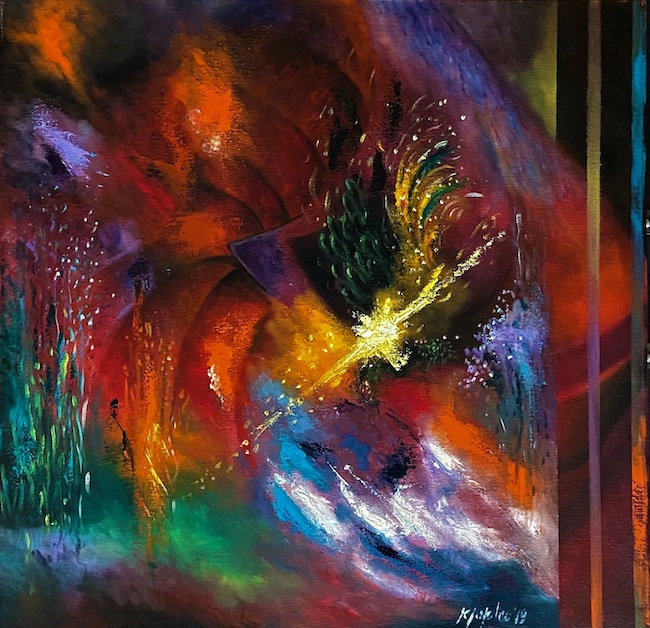
La tela Il Cassetto dei Sentimenti appartiene a questa serie, una vera e propria esplosione di tonalità vivaci e vitali esattamente come le emozioni che fuoriescono da un’interiorità sensibile e profonda la quale non può rimanere in silenzio riposta in quello spazio limitato in cui spesso si desidererebbe tenerla per proteggerla; sembra un mondo sotterraneo l’opera, un giardino segreto all’interno del quale le sensazioni danzano in modo dolce ma al tempo stesso travolgente, sottolineando la forza e l’impetuosità di tutto ciò che lascia un segno nell’esistenza, di tutto ciò che dipinge la vita di quell’intensità necessaria a rendere ogni frangente indimenticabile.
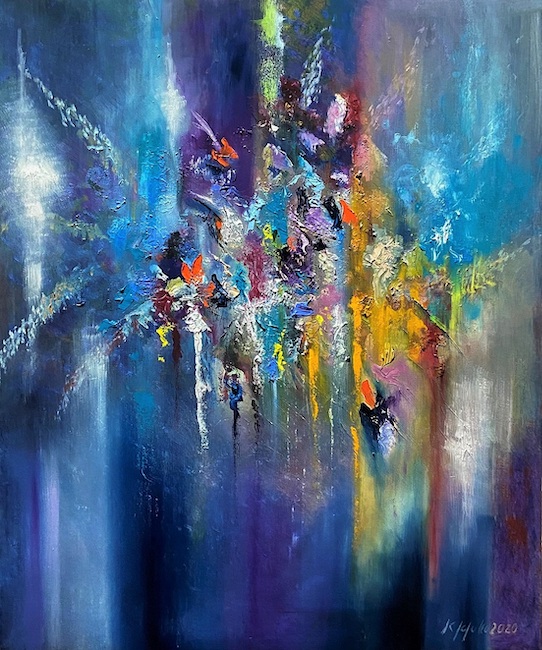
Nel corso della sua lunga carriera artistica Katia Papaleo ha partecipato a oltre settanta mostre tra collettive e personali, ha vinto numerosi premi, nel 2017 ha ricevuto la nomina di Maestro d’arte e nel 2019 le è stata conferita la Laurea Honoris Causa dall’Accademia di Santa Sara di Alessandria; le sue opere sono inserite in importanti cataloghi d’arte contemporanea e dal 2018 è Presidente dell’Associazione Artistica Culturale Artangolo-Fucina delle Arti a Milano.
KATIA PAPALEO CONTATTI
Email: katiapapaleo@gmail.com
Sito web: https://katiusciapapaleo.it/it/
Facebook: https://www.facebook.com/katia.papaleo
Instagram: https://www.instagram.com/katiapapaleo/
The enchanted world of Katia Papaleo, suspended between magic and exciting intuition
Everything that belongs to irrationality tends to be put in the background compared to contingency, to the observation of what moves around the contemporary world with its problems, its fake freedoms that are actually cages within which the human being, and even more so the artist, moves to explore the deeper meanings, trapping himself in a mechanism of cause and effect that does not allow him to get out of that mental and emotional vortex. The artist I am going to tell you about today, on the other hand, uses the act of painting to bring out the magical side of the universe we inhabit, made up of subtle energies, characters and apparently ordinary objects that reveal the infinite possibilities of a parallel world in which everything can change its essence and be transformed.
Starting from the very last years of the 19th century, with the research on colour and emotion of the artists who contributed to theorizing the guidelines of Fauvism, taken up and elaborated in their less extreme meaning by the subsequent Expressionism, the need to escape from contingency began to emerge in some protagonists of the time, from a period in which class struggles and the subsequent winds of war induced some creatives with a particular sensitivity to seek an escape route, a way of distracting themselves from the happenings and the succession of events due to which the emotions absorbed could only be panic, fear, anxiety, anguish. This need to escape from reality had its greatest representative in Marc Chagall, whose playful, light atmospheres set in fairy-tale settings won over the public and experts alike precisely because of their ability to distract from an often too tiring, sad reality, and to draw the observer into that smiling, perhaps deliberately unconscious world in which to be simply happy. A few years later, that sense of innocence and pleasantness that emanated from the magic of existence, from those little emotions given by love, from the sensation of rising and flying above cities and landscapes with the same irrational desire of a child, were mitigated and linked to a greater sense of reality within which, however, the artists went in search of that very magic that was most manifest in Chagall; this new approach was defined Magic Realism and, although it was never a movement defined and determined by a manifesto, it had its greatest representatives in Felice Casorati in Italy, Christian Shad in Germany and George Tooker in the United States. It was especially in the United States that Magical Realism took on many of the surrealist themes, but gave predominance to the magic and atmosphere of fairytales and dreams, thus generating Pop Surrealism, which affected not only art but also cinema. The great director Tim Burton is part of this expressive current, as is the great painter Margaret Keene, who was in some ways a precursor of the new pictorial style, and then more recently Mark Ryden, whose unreal atmospheres range from the world of fairy tales to that of nightmares, constantly concealing an ironic vein of reality. Milanese artist Katia Papaleo bridges the gap between Magic Realism and Pop Surrealism by describing a world very close to the cinematic atmospheres of Tim Burton, in which fantastical and mysterious but always positive characters and objects revolve, almost as if the director, like Papaleo, were revealing their indulgence, their benevolence towards the oddities that come and go in an apparently random way in the life of each of us.
The range of colours chosen by the artist also harmonises with his way of observing circumstances, events and those details of existence that demonstrate a different meaning, often hidden yet evident to those who know how to look beyond it; things take on a living aspect, becoming metaphors of contemporary reality or, if observed from another point of view, they become a way of perceiving that link between objects and subtle energies that envelop the atmosphere that usually surrounds the individual without him being aware of it. The work Fermare il tempo (Stopping Time) cannot but bring to mind the Arabian amphorae in which precious oils are contained, narrated by Papaleo through tiny multicoloured particles and tiny golden fragments, almost as if they were gold ingots, underlining how important it is to consider the passing of events and life as a wonderful and unique experience; this is why it is necessary to realise how essential it is to savour each instant because it will inevitably slip away, despite man’s efforts to stop it, so as not to let a pleasant and joyful moment dissolve, but one that passes. Reflection on time is a theme addressed by Katia Papaleo from different angles, a concept that belongs to the present as much as to the past because it has always been an enigma, an unattainable chimera precisely because of its fleetingness, which does not belong to the point of view of the human being, who is often deludedly convinced that he can control it, that he can dispose of it as he pleases, only to have to reckon with everything that has passed much faster than he has been able to observe. In the painting Il tempo prezioso (The precious Time), the artist evokes a magical atmosphere, made up of shades of blue, the colour of dreams and imagination, in which a clock dominates an open door representing opportunities, chances to be grasped, attempts to be undertaken so as not to find oneself later regretting what was not seized. On the contrary, it seems to suggest to the observer how much beauty can be hidden beyond the decision to cross an unknown threshold, to find the courage to take that leap, to perform that action which can change the course of one’s entire existence.
Il matto che profuma di vita (The madman who smells of life) is an amusing character, resembling the Mad Hatter from Alice in Wonderland, and represents the imagination inherent in each individual, which in some cases is transformed into creative strength, into an expressive capacity to tell of the emotions, sensations and colours that define the soul; the madman basically symbolises the artist, his inner world told through images in a universal language capable of reaching the observer by virtue of immediacy, who can see the light through the darkness and find the playful and amusing side of life, despite everything. In other paintings, those more linked to interior sensations, to fragments of memory or reality that are filtered through her deepest feelings, Papaleo moves towards Abstract Expressionism in which the colours become the protagonists and narrate the emotions, what is perceived with immediacy and what must come out with equal spontaneity, without the filter of the mind, without awareness, but with the sometimes childish impulsiveness of simply wanting to narrate what revolves in that delicate interiority that represents all that the human being has at his disposal not to lose himself in contingency.
The canvas Il cassetto dei sentimenti (The drawer of feelings) is part of this series, a veritable explosion of lively and vital colours, just like the emotions that come out of a sensitive and profound interiority that cannot remain silent in that limited space where we often wish to keep it for protection; the work seems to be an underground world, a secret garden in which sensations dance in a gentle but at the same time overwhelming way, underlining the strength and impetuousness of everything that leaves its mark on existence, of everything that paints life with the intensity necessary to make every event unforgettable. During her long artistic career, Katia Papaleo has taken part in more than seventy exhibitions, including group and solo shows, she has won numerous awards, in 2017 she was appointed Master of Art and in 2019 she was awarded an Honorary Degree by the Academy of Santa Sara in Alessandria; her artworks are included in important contemporary art catalogues and since 2018 she has been President of the Artangolo-Fucina delle Arti Cultural Association in Milan.


